Neuregulin/erbb signaling and integrin
a technology of which is applied in the field of neuregulin/erbb signaling and integrin, can solve the problems of unclear molecular mechanism underlying this phenomenon, and achieve the effect of inhibiting cell proliferation
- Summary
- Abstract
- Description
- Claims
- Application Information
AI Technical Summary
Benefits of technology
Problems solved by technology
Method used
Image
Examples
example 1
Direct Binding of Integrin αvβ3 to NRG1 (175-222)
[0199]Direct αvβ3-NRG (175-222) interaction: It has been well established that the EGF-like domain of the NRGs is sufficient to specifically activate ErbB receptors and to induce cellular responses in culture. To generate GST-NRG1 EGF-like domain fusion protein, the cDNA fragment of the EGF-like domain of NRG1 was amplified by PCR and subcloned into PGEX-2T vector to generate GST-NRG1 EGF-like domain fusion protein (designated GST-NRG1 (175-222)) in E. coli BL21. The fusion protein was purified in glutathione-affinity chromatography. The affinity resin was extensively washed with 1% Triton X-114 to remove endotoxin before eluting the protein. It was tested, in the present invention, whether soluble recombinant integrin αvβ3 binds to GST-NRG1 (175-222) that is immobilized to plastic wells (ELISA-type assay). Recombinant soluble αvβ3 integrin bound to the 3KE (175-222) mutant (isolated EGF-like domain) in a dose-dependent manner (FIG. 1...
example 2
Integrin-Binding Defective Mutant of NRG1
[0201]Docking simulation and mutagenesis: To locate the integrin-binding site in NRG1 and to generate integrin-binding-defective mutants of NRG 1, docking simulation and site-directed mutagenesis were used. Docking simulation of the interaction between integrin αvβ3 and the EGF-like domain of NRG1 predicts that NRG binds to integrin αvβ3 with a high affinity (docking energy −23.5 kcal / mol), which is consistent with our binding results. Also the simulation predicted that the integrin-binding site is distinct from the EGFR-binding site of NRG using the TGFα-EGFR complex, PDB code 1MOX, since EGF and TGFα are homologous. The simulation suggests that integrins and ErbB receptors do not block access of NRG1 to each other (FIG. 4). The predicted integrin-binding interface includes Lys residues at positions 181, 185, and 187, which are conserved in NRG1 and NRG2. A NRG mutant that does not bind to integrins was generated by mutating of Lys181 / Lys185...
example 3
Integrin-Binding-Defective Mutants of NRG1 (175-222)
[0204]Docking simulation predicted the potential integrin-binding interface, which included Lys residues at positions 181, 185, and 187. NRG (175-222) mutants that do not bind to integrins were generated by mutating of Lys181 / Lys185 / Lys187 simultaneously to Glu residues (designated the 3KE (175-222) mutation) or Lys185 / Lys187 to Glu (designated the 2KE (175-222) mutation). Both 2KE (175-222) (FIG. 7) and 3KE (175-222) mutants showed much lower affinity to αvβ3. The mutated Lys residues are located on the side opposite to the ErbB-binding site, indicating that the integrin-binding-defective mutants may interact with ErbB.
PUM
| Property | Measurement | Unit |
|---|---|---|
| concentrations | aaaaa | aaaaa |
| pH | aaaaa | aaaaa |
| pH | aaaaa | aaaaa |
Abstract
Description
Claims
Application Information
 Login to View More
Login to View More - R&D
- Intellectual Property
- Life Sciences
- Materials
- Tech Scout
- Unparalleled Data Quality
- Higher Quality Content
- 60% Fewer Hallucinations
Browse by: Latest US Patents, China's latest patents, Technical Efficacy Thesaurus, Application Domain, Technology Topic, Popular Technical Reports.
© 2025 PatSnap. All rights reserved.Legal|Privacy policy|Modern Slavery Act Transparency Statement|Sitemap|About US| Contact US: help@patsnap.com



